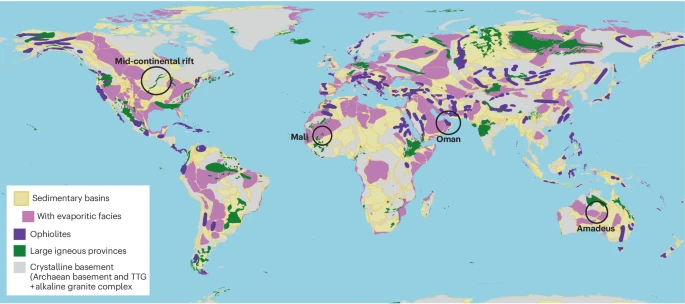Scientists have uncovered evidence that naturally occurring hydrogen gas, trapped deep within Earth’s crust, could provide a vast, low-carbon energy resource equivalent to 170,000 years of current global oil consumption. This revelation, detailed in a comprehensive review published in Nature Reviews Earth & Environment, suggests that “natural hydrogen” might play a significant role in the global energy transition – if we can figure out how to find and extract it economically.
The study, authored by researchers from the University of Oxford, the University of Toronto and Durham University, maps out how hydrogen accumulates in Earth’s continental crust through natural processes that have been operating for billions of years. Unlike manufactured hydrogen, which currently generates approximately 900 million tons of carbon dioxide annually (2.4% of global emissions), natural hydrogen could be extracted with a minimal carbon footprint.
But can we realistically tap into these reserves, or is this merely geological curiosity rather than practical energy solution?
How Earth Manufactures Hydrogen
The review identifies two primary mechanisms driving natural hydrogen formation in the continental crust. The first occurs when water interacts with iron-rich rocks, particularly ultramafic rocks like peridotite. In these reactions, ferrous iron (Fe2+) is oxidized to ferric iron (Fe3+), releasing hydrogen molecules in the process.
The second mechanism, known as radiolysis, happens when radioactive elements like uranium, thorium, and potassium – found naturally in crustal rocks – emit radiation that splits water molecules into their component parts, including hydrogen.
“These two generation reactions operate on very different timescales, ranging from thousands to millions of years for water–rock reactions in highly fractured rocks, to tens to hundreds of millions of years for water-limited water–rock and radiolysis reactions,” the researchers explain in their review.
These processes have created truly staggering amounts of hydrogen over geological time. The researchers calculate that over the past billion years, hydrogen energy generated in the Archaean crust alone equates to approximately 170,000 years of present-day global oil consumption – a tantalizing figure for energy strategists.
Four Geological Settings With Hydrogen Potential
The study identifies four main geological settings where natural hydrogen might accumulate in commercially viable quantities:
- Continental margin ophiolite complexes – slices of oceanic crust thrust onto continents during tectonic collisions
- Alkaline granite terranes – radiogenic granites that can generate hydrogen through water radiolysis
- Large igneous provinces – extensive volumes of mafic rocks that could generate hydrogen through water-rock reactions
- Archaean greenstone belts and tonalite-trondhjemite-granodiorite (TTG) granitic batholiths – ancient rock formations containing both water-rock and radiolytic hydrogen sources
Significantly, these geological formations are widely distributed across all continents, suggesting natural hydrogen could potentially be a globally accessible resource rather than concentrated in specific regions.
Mali’s Hydrogen Mystery
While the existence of natural hydrogen has been documented throughout the 20th century, interest in its commercial potential surged following reports of the Bourakebougou gas field in Mali in 2018. This site produces hydrogen with more than 97% purity, though production volume data remain limited.
The Mali discovery exemplifies how hydrogen can accumulate in geological traps similar to those that contain natural gas. For hydrogen to form extractable accumulations, four conditions must be met: a hydrogen source, a migration pathway, a sealed trap, and preservation from microbiological or chemical degradation.
The researchers note that preserving hydrogen over geological time presents unique challenges, as hydrogen is both highly mobile and susceptible to consumption by subsurface microbes. This explains why, despite the vast quantities generated over geological history, only a fraction might be recoverable today.
Not Renewable, But Sustainable
The study makes a crucial distinction that could shape how natural hydrogen is regulated and marketed: while possessing a low carbon footprint comparable to “green hydrogen” produced through renewable-powered electrolysis, natural hydrogen is not a renewable resource on human timescales.
“Continental systems do not provide a regenerating hydrogen system on decadal to centennial timescales, and should not be considered a renewable resource,” the research team concludes.
This places natural hydrogen in a unique category – a potentially low-carbon energy source that, like fossil fuels, exists in finite quantities, but with a vastly larger reserve base and significantly lower environmental impact during extraction.
The authors estimate that natural hydrogen could be produced for approximately $0.50-1.00 per kilogram, substantially less than both “green hydrogen” ($2.50-6.50/kg) and “blue hydrogen” derived from natural gas with carbon capture ($1.50-4.00/kg).
Challenges and Knowledge Gaps
Despite its promise, significant knowledge gaps remain. The researchers identify several priorities for future investigation, including better understanding how much hydrogen remains trapped in Earth’s crust, improving methods for calculating hydrogen generation rates from water-rock reactions, and developing techniques to locate and assess economically viable hydrogen accumulations.
The study’s authors caution that while large accumulations of hydrogen are feasible, very high-purity hydrogen deposits like the one in Mali may prove exceptional. More commonly, natural hydrogen might be found mixed with other gases like helium and nitrogen – still valuable, but requiring different extraction and processing approaches.
“For exploration to be successful, predicting the amount and timing of hydrogen generated will be critical,” the researchers emphasize. This will require integrating geological, geophysical, and geochemical data to understand where hydrogen might be trapped and in what quantities.
As the world seeks pathways to decarbonize “hard-to-abate” sectors like fertilizer production, steel manufacturing, and long-distance transport, the discovery and development of natural hydrogen resources could provide a transitional energy source with significantly lower environmental impact than current hydrogen production methods. While not a silver bullet for the energy transition, this untapped resource may soon join the portfolio of solutions helping to reduce global carbon emissions.
If our reporting has informed or inspired you, please consider making a donation. Every contribution, no matter the size, empowers us to continue delivering accurate, engaging, and trustworthy science and medical news. Independent journalism requires time, effort, and resources—your support ensures we can keep uncovering the stories that matter most to you.
Join us in making knowledge accessible and impactful. Thank you for standing with us!

